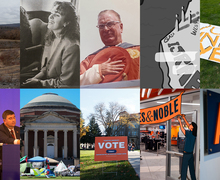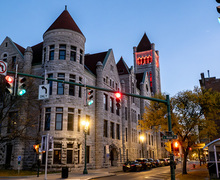Engineer lectures on design, shows photos
As structural engineer Guy Nordenson displayed pictures of the Jubilee Church in Rome, he spoke of its qualities and the construction process that took place to create such a unique building in a residential Italian neighborhood.
The church is a white, curved structure with concrete walls that are able to self-clean and remove dirt and pollution from the air, said Nordenson, the structural engineer for the Jubilee Church.
Though the construction of the church was lengthened due to the contractors’ tendency to place a single concrete block in the morning and another at night, he praised the energy and deliberate construction process that ensued.
Nordenson presented his lecture ‘Patterns and Structure’ Tuesday at 4:30 p.m. in Slocum Hall Auditorium. The event was co-sponsored by Syracuse University’s School of Architecture and the L.C. Smith College of Engineering and Computer Science.
Nordenson is a professor of architecture and structural engineering at Princeton University and began his own structural engineering firm in 1997.
During Tuesday’s lecture, Nordenson referred to a slideshow displaying a few of the more than 100 structures he has worked on.
‘Many minds come together on these projects, and unique occurrences contribute to architecture,’ Nordenson said. ‘There is an energy in collaboration.’
Nordenson was invited to speak at SU because of his knowledge of both engineering and architecture, said Sinead Mac Namara, an assistant professor of civil and environmental engineering who is involved in planning the lecture. Nordenson’s successes provide students with a view of both studies, she said.
In addition to the Jubilee Church, Nordenson was the structural engineer for the Museum of Modern Art expansion in New York City. Working with a Japanese architect, Nordenson designed a 60-foot wall of windows supported by solid steel bars for the museum, and he noted the extreme challenge for such a small structure.
The design was difficult because the steel bars were thin in comparison to the glass that was used for the windows, he said.
There is value to the idea that a structure can have ‘more than meets the eye,’ Nordenson said, stating his desire to design structures that reveal themselves through deeper study.
Nordenson has been involved in the design of structures at a few universities in the United States, including the Hillhouse Bridges at Yale University and Simmons Residence Hall at the Massachusetts Institute of Technology.
At MIT, the exterior of the residence hall has many different colors, representative of the different types of steel used in the structure, he said.
Nordenson is also the commissioner and secretary of the New York City Public Design Commission and is involved in earthquake engineering and long-range planning for the Federal Emergency Management Agency.
Expecting a rise in sea levels, he currently plans options to make the New York City area more resistant to climate change by studying the evolution of coastal boundaries and analyzing flooding scenarios. He suggested the construction of hard barriers to protect the area or the creation of islands, piers and wetlands in the bay.
Nathaniel Danciger, a second-year architecture student, said the combination of the buildings’ aesthetics and function in the projects was interesting.
Said Danciger: ‘It was really interesting how there was always an underlying concept behind the structures.’
Published on February 15, 2011 at 12:00 pm
Contact Breanne: brvannos@syr.edu | @bre_vann





